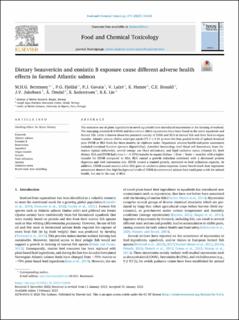| dc.contributor.author | Berntssen, Marc HG | |
| dc.contributor.author | Fjelldal, Per Gunnar | |
| dc.contributor.author | Gavaia, P.J. | |
| dc.contributor.author | Laizé, V. | |
| dc.contributor.author | Hamre, Kristin | |
| dc.contributor.author | Donald, Carey | |
| dc.contributor.author | Jakobsen, J.V. | |
| dc.contributor.author | Omdal, A. | |
| dc.contributor.author | Søderstrøm, Karin Sofie | |
| dc.contributor.author | Lie, Kai Kristoffer | |
| dc.date.accessioned | 2024-01-10T09:24:36Z | |
| dc.date.available | 2024-01-10T09:24:36Z | |
| dc.date.created | 2023-05-09T14:58:53Z | |
| dc.date.issued | 2023 | |
| dc.identifier.citation | Food and Chemical Toxicology (FCT). 2023, 174 . | |
| dc.identifier.issn | 0278-6915 | |
| dc.identifier.uri | https://hdl.handle.net/11250/3110795 | |
| dc.description.abstract | The extensive use of plant ingredients in novel aquafeeds have introduced mycotoxins to the farming of seafood. The emerging enniatin B (ENNB) and beauvericin (BEA) mycotoxins have been found in the novel aquafeeds and farmed fish. Little is known about the potential toxicity of ENNs and BEA in farmed fish and their feed-to-organ transfer. Atlantic salmon (Salmo salar) pre-smolt (75.3 ± 8.10 g) were fed four graded levels of spiked chemical pure ENNB or BEA feeds for three months, in triplicate tanks. Organismal adverse health end-point assessment included intestinal function (protein digestibility), disturbed hematology (red blood cell formation), bone formation (spinal deformity), overall energy use (feed utilization), and lipid oxidative status (vitamin E). Both dietary BEA and ENNB had a low (<∼0.01%) transfer to organs (kidney > liver > brain > muscle), with a higher transfer for ENNB compared to BEA. BEA caused a growth reduction combined with a decreased protein digestion and feed conversion rate- ENNB caused a stunted growth, unrelated to feed utilization capacity. In addition, ENNB caused anemia while BEA gave an oxidative stress response. Lower bench-mark dose regression assessment showed that high background levels of ENNB in commercial salmon feed could pose a risk for animal health, but not in the case of BEA. | |
| dc.language.iso | eng | |
| dc.title | Dietary beauvericin and enniatin B exposure cause different adverse health effects in farmed Atlantic salmon | |
| dc.title.alternative | Dietary beauvericin and enniatin B exposure cause different adverse health effects in farmed Atlantic salmon | |
| dc.type | Peer reviewed | |
| dc.type | Journal article | |
| dc.description.version | publishedVersion | |
| dc.source.pagenumber | 13 | |
| dc.source.volume | 174 | |
| dc.source.journal | Food and Chemical Toxicology (FCT) | |
| dc.identifier.doi | 10.1016/j.fct.2023.113648 | |
| dc.identifier.cristin | 2146523 | |
| dc.relation.project | Norges forskningsråd: 281032 | |
| cristin.ispublished | true | |
| cristin.fulltext | original | |
| cristin.qualitycode | 1 | |
